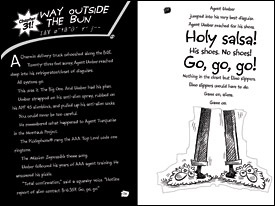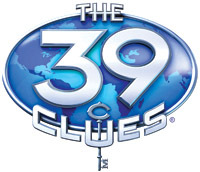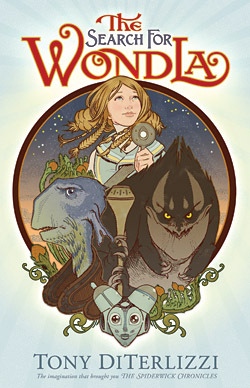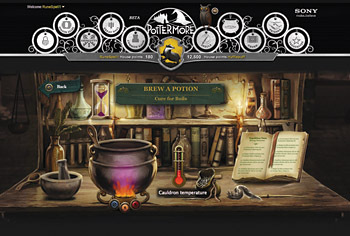By Joy Fleishhacker
These transmedia titles operate on a variety of platforms to support and extend the reading experience and tantalize tech-savvy youngsters who like to spend their leisure time plugged in.
“Spaceheadz” Series (S&S; Gr 3–6)
It’s hard enough being the new kid at school, but when Michael K. is buddied up with two oddball students by their fifth-grade teacher, he soon discovers that Jennifer and Bob are aliens from another planet who must recruit 3.14 million (plus 1) kids to become Spaceheadz… or Earth will be turned off.
 Jon Scieszka’s laugh-out-loud text and Shane Prigmore’s droll cartoons depict the zany happenings. As youngsters read the books, they can browse several well-designed Web destinations, including Major Fluffy’s blog, Mrs. Halley’s classroom homepage, and the website for the Anti-Alien Agency, the super hush-hush organization that’s in hot pursuit of the extraterrestrials.
Jon Scieszka’s laugh-out-loud text and Shane Prigmore’s droll cartoons depict the zany happenings. As youngsters read the books, they can browse several well-designed Web destinations, including Major Fluffy’s blog, Mrs. Halley’s classroom homepage, and the website for the Anti-Alien Agency, the super hush-hush organization that’s in hot pursuit of the extraterrestrials.
In addition, kids can visit the website “created” by the characters to sign up and volunteer their own brain waves (the count instantly increases by one) and access other fun features, including video. These online elements draw youngsters further into the tale by adding detail and backstory to the plot, and provide an opportunity for creativity (viewers can upload their own stories and photos).
“39 Clues” Series (Scholastic; Gr 4–7)
 Combining books, collectable game cards, and an interactive website, this groundbreaking multi–platform series presents puzzles and perils galore, as siblings Dan and Amy Cahill race against time—and other Cahills, many of the ruthless sort—to track down clues scattered worldwide that will reveal the secret source of their family’s power. The action bursts beyond the page as readers go online to create an account, participate in secret missions (interacting with characters or completing games to unlock clues), and upload codes from the cards to reveal hidden tidbits. There’s plenty to explore, and the full–color photos and slick graphics add to the fun. Frequent references to the books will keep kids reading. The adventures continue online and in print with the recently launched “Cahills vs. Vespers” series.
Combining books, collectable game cards, and an interactive website, this groundbreaking multi–platform series presents puzzles and perils galore, as siblings Dan and Amy Cahill race against time—and other Cahills, many of the ruthless sort—to track down clues scattered worldwide that will reveal the secret source of their family’s power. The action bursts beyond the page as readers go online to create an account, participate in secret missions (interacting with characters or completing games to unlock clues), and upload codes from the cards to reveal hidden tidbits. There’s plenty to explore, and the full–color photos and slick graphics add to the fun. Frequent references to the books will keep kids reading. The adventures continue online and in print with the recently launched “Cahills vs. Vespers” series.
The Search for WondLa (S&S, 2010; Gr 5–8).
Raised in isolation by a loving robot, 12-year-old Eva Nine sets off on a perilous journey to seek other humans like herself, meeting an array of strange life forms along the way. Blending sci-fi tech and fairytale whimsy, Tony DiTerlizzi’s absorbing narrative and detailed illustrations depict the vividly imagined world of Orbona. Readers can take the visualization process one step further by visiting wondla.com to explore the realm’s sights and sounds via “WondLa Vision” (augmented reality). By holding the book’s special illustrations up to a webcam, they unlock a three-dimensional interactive map enhanced by music, motion, and sound effects.
strange life forms along the way. Blending sci-fi tech and fairytale whimsy, Tony DiTerlizzi’s absorbing narrative and detailed illustrations depict the vividly imagined world of Orbona. Readers can take the visualization process one step further by visiting wondla.com to explore the realm’s sights and sounds via “WondLa Vision” (augmented reality). By holding the book’s special illustrations up to a webcam, they unlock a three-dimensional interactive map enhanced by music, motion, and sound effects.
Three separate sections are revealed at correlating plot points, mirroring Eva’s expedition and adding a sense of immediacy. An Omnipod—the handheld mechanical device that Eva uses to gather and retrieve information—flashes on the screen before accessing the map, making viewers feel as though they’re looking through her eyes.
“The Magnificent 12” Series (Katherine Tegen/HarperCollins; Gr 5–8)
Mack, a seemingly average middle schooler, discovers that he’s one of a group of magic-wielding 12-year-olds and sets off on a quest to find the other 11 Magnifica and save the world from a terrifying evil. Michael Grant’s tale sparkles with snicker–inducing humor, enchanting fantasy elements, and fast-paced adventures. Black-and-white images of the characters sprinkled throughout the text lead readers to the website, where they’ll find extensive, brightly illustrated content.
Online, kids can read detailed and often entertaining entries about the people, creatures, places, and things presented in the books. An interactive map introduces the international locations visited by the protagonists with local tidbits, quizzes, and entries from Mack’s travel journal, and online games underscore various plot elements. Viewers can register to create their own avatar, earn points to unlock content and win prizes, participate in challenges (e.g., draw and upload a character), and tap into a virtual community of like-minded fans. There’s depth to the site, and it’s well-matched in tone to the novels, making it a satisfying destination for readers.
“The Amanda Project” Series (HarperTeen, Gr 7–10)
 When high school student Amanda Valentino disappears under unexplained circumstances, her three closest friends form an alliance to find her, but as they piece together cryptic clues left behind by the enigmatic Amanda, the mystery of her whereabouts—and just who she is—only seems to deepen. Secrets, subplots, and unexpected twists will leave readers longing for more.
When high school student Amanda Valentino disappears under unexplained circumstances, her three closest friends form an alliance to find her, but as they piece together cryptic clues left behind by the enigmatic Amanda, the mystery of her whereabouts—and just who she is—only seems to deepen. Secrets, subplots, and unexpected twists will leave readers longing for more.
The tie–in website is a destination “created” by the characters to gather info about their missing friend. Here, teens immerse themselves in Amanda’s world, not only by reading and responding to weekly postings of stories and clues from the book’s protagonists, but also by collaborating on the content: users can craft an online identity, write their own part of the story (of run-ins with Amanda), post their theories or chat about the book on a community forum, and upload creative writing and artwork (user work has been incorporated into the books). The site provides a teen-appealing mix of drama and mystery, and provides opportunity for both creative input and social networking.
“Pottermore” (Gr 4 Up)
Created by J.K. Rowling, this new endeavor will captivate and delight devotees of the Harry Potter books (Scholastic) and extend his literary world to new frontiers. The site invites viewers to explore Harry Potter and the Philosopher’s Stone, with other installments to be added over time. (The beta phase has been extended, with users being admitted to the site in phases.)
Chapter by chapter, colorfully illustrated scenes re-create memorable “moments” such as a street-side view of “Number Four, Privet Drive” or a glimpse at “The Cupboard Under the Stairs.” Kids can investigate each vista by clicking their mouse to zoom in and out on details (and perform simple actions such as lighting a candle), collect various objects, and unlock content.
Some of the scenes incorporate games or tasks that must be completed before moving on (e.g., catching the Golden Snitch). Though the variety presented in each scene keeps things interesting, it’s not always clear just what objects can be collected each time, and what they will ultimately be used for (they are stored in a virtual “Trunk”).
Each “moment” also presents text excerpts and a “Read About” section that further describe featured characters, places, objects, and creatures. Highlighted by a quill pen icon, a wealth of new material provided by Rowling includes added story elements as well as her thoughts about and inspirations for a variety of narrative details (character and locale names, etc.). 
In these sections, the author delves into the backgrounds of numerous characters (revealing, for example, how Vernon and Petunia Dursley met and how their relationship with Harry’s parents went sour, or Professor McGonagall’s long-ago love affair with a Muggle boy) and re-examines story basics (a history of the Hogwarts Express; a discourse on “Wand Woods,” or more about the “Mirror of Erised”). Scattered throughout, these appealing tidbits add both depth and detail to the familiar universe and will satisfy dedicated book fans who are hungry for more.
As youngsters progress through the chapters, they take part in the tale, opening a bank account at Gringotts and visiting the shops in Diagon Alley to purchase school supplies, answering questions to be chosen for a wand, experiencing the Sorting Hat ceremony (introduced by a video of Rowling), and then moving forward to earn points for his or her designated house.
Social networking elements allow participants to post comments, interact with other users, follow the progress of friends, and upload drawings. The site’s chapter-by-chapter organization and detailed content encourages kids to read or re-read the books as they explore each section, thus creating a rewarding interplay between page and screen. With so many different features and activities that challenge a variety of abilities, “Pottermore” holds appeal for a wide age range of participants.
Some of the games require patience and persistence (it was devilishly hard to brew a first potion but rewarding once accomplished), making independent perusal of the site most appropriate for those old enough to read the books (Gr 4 Up); however, younger readers, who have perhaps had the novels read aloud to them, may enjoy exploring “Pottermore” along with a parent or adult.
Though registration is free, the site will include a “Pottermore Shop,” where “readers will be able to purchase exclusively and download the digital Harry Potter audio books and, for the first time, the Harry Potter eBooks.”
Author Information
Joy Fleishhacker (jfleishhacker@hotmail.com) is a librarian, former SLJ staffer, and freelance writer who lives in Colorado.



More than just a tie-in website, transmedia should make the story live across multiple mediums. The vanguard author of the transmedia has to be Patrick Carman. To anyone who only knows him as a contributing author to the “39 Clues” books, you certainly have missed the depth of Carman’s commitment to the both the artform and literacy. The “Trackers” and “Skeleton Creek” series both split their stories between mediums, and the “3:15” series is broken into small “episodes”, each with audio, video, and written components. You can’t talk transmedia without talking Patrick Carman!